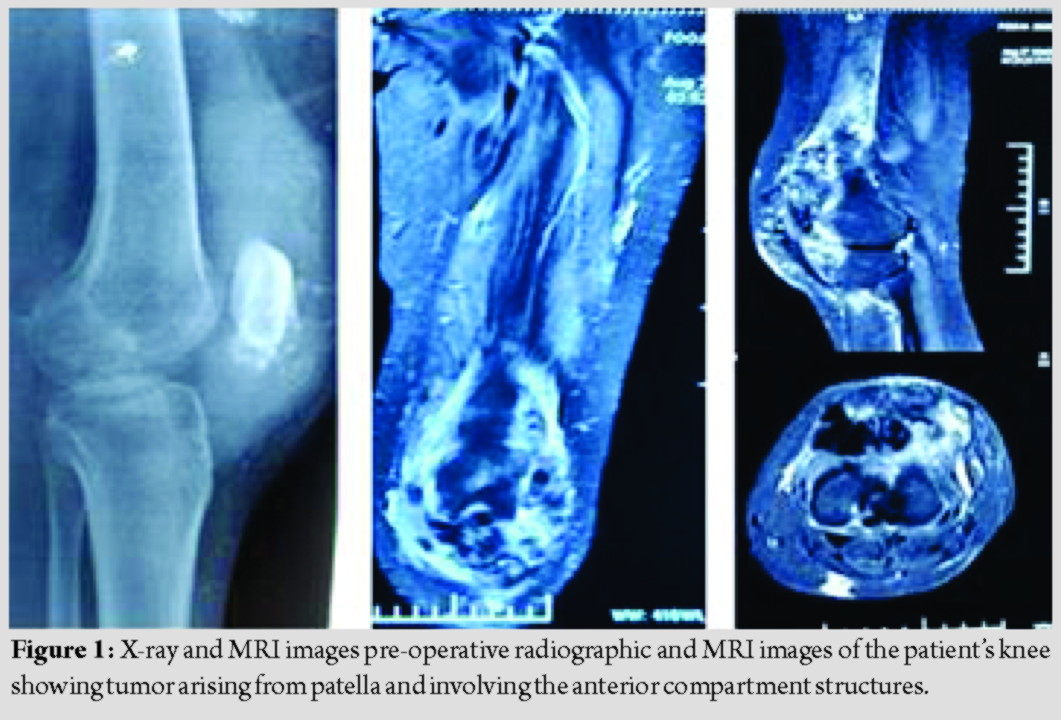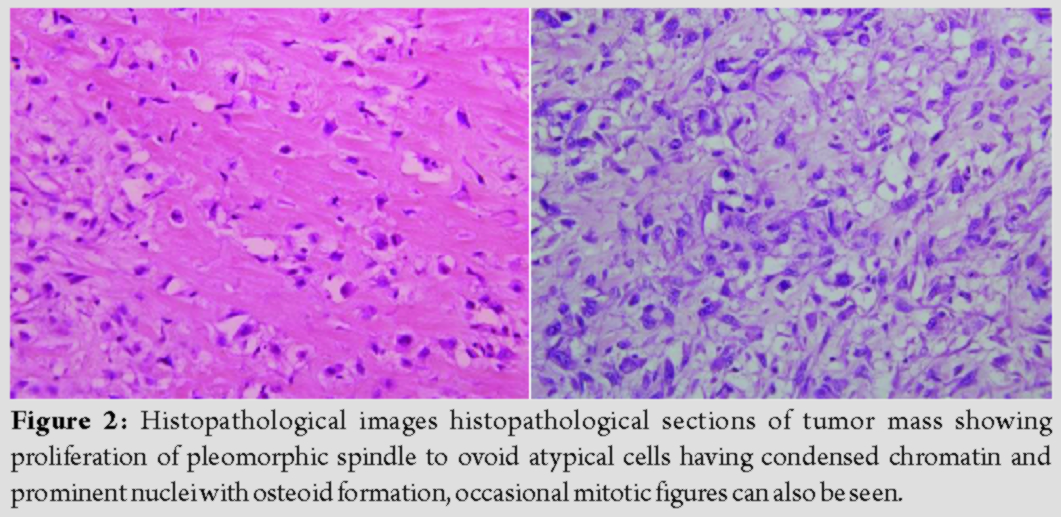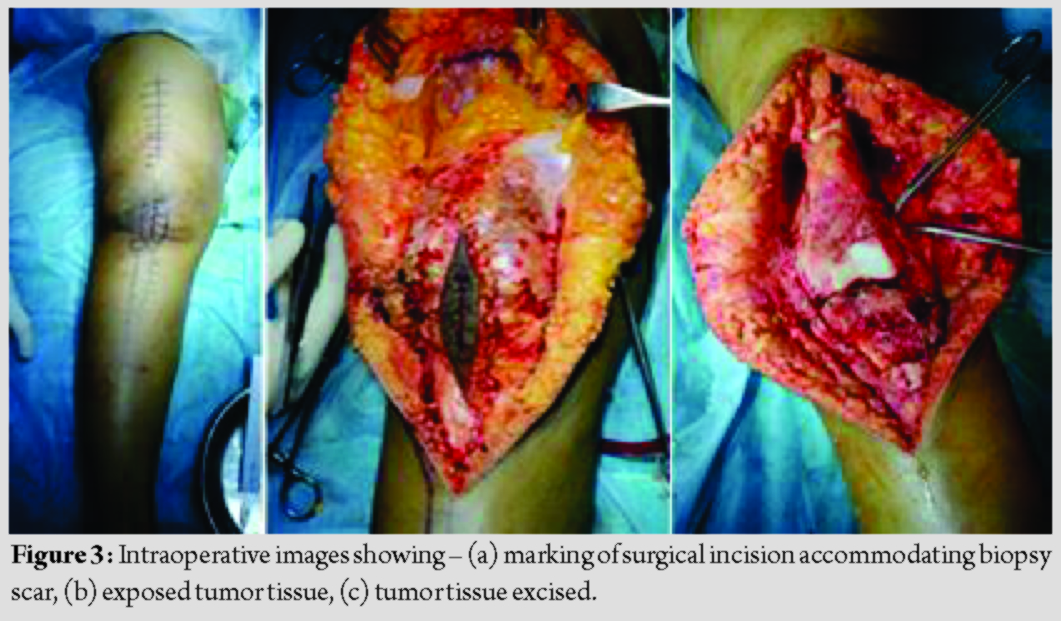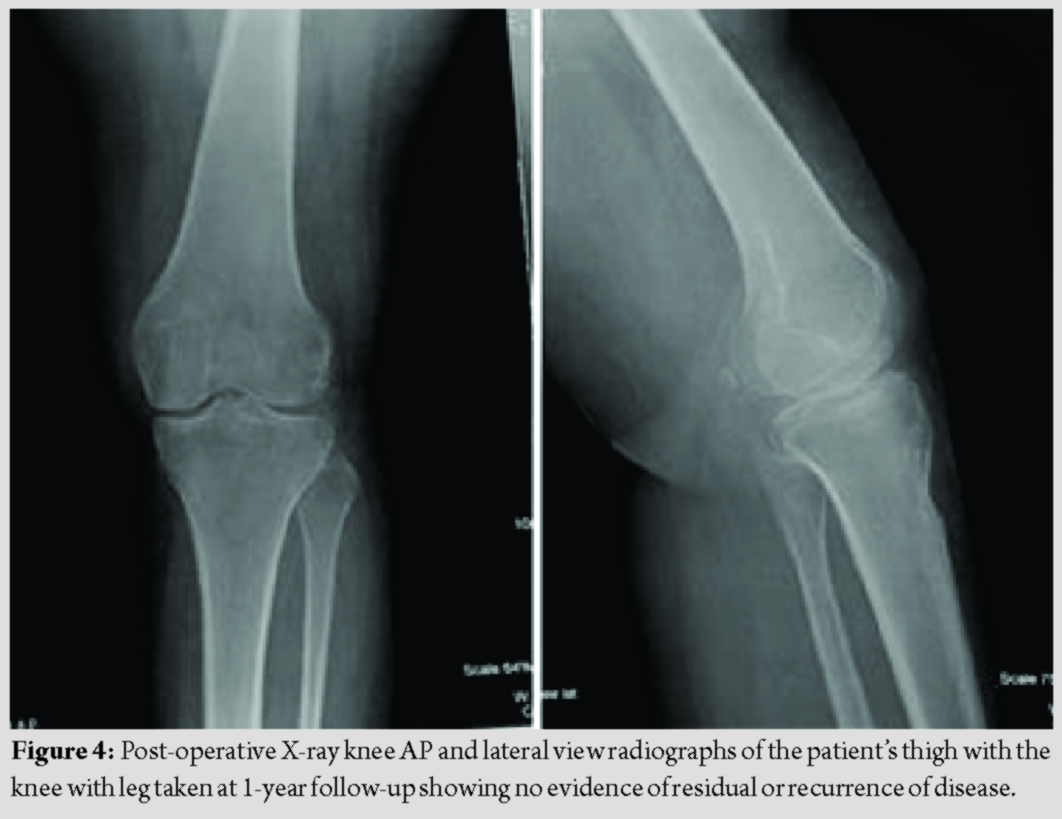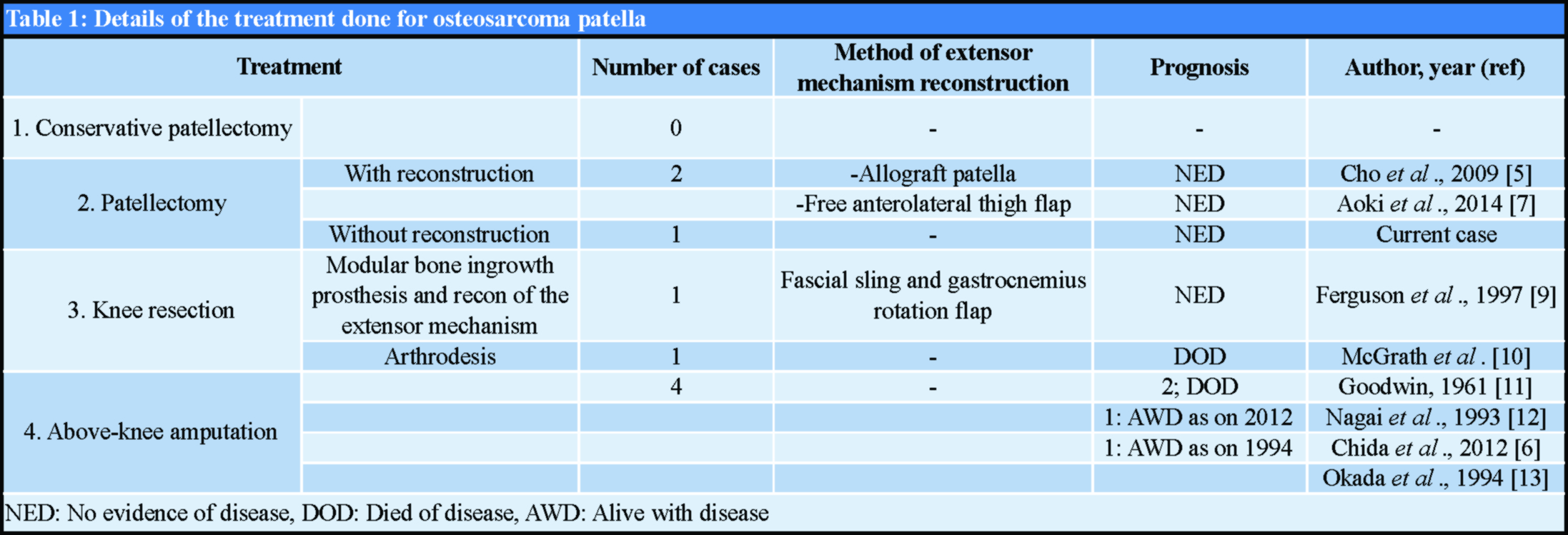[box type=”bio”] Learning Point of the Article: [/box]
Osteosarcoma patella can be managed well without extensor mechanism reconstruction.
Case Report | Volume 10 | Issue 3 | JOCR May – June 2020 | Page 67-70 | Gaurang Agarwal, Raj Kumar, Bharat Dhanjani, Lalit Maini. DOI: 10.13107/jocr.2020.v10i03.1754
Authors: Gaurang Agarwal[1], Raj Kumar[1], Bharat Dhanjani[2], Lalit Maini[1]
[1]Department of Orthopaedics, Maulana Azad Medical College and Lok Nayak Hospital, New Delhi, India,
[2]Department of Orthopaedics, Asian Hospital, Faridabad, Haryana, India.
Address of Correspondence:
Dr. Gaurang Agarwal,
Department of Orthopaedics, Maulana Azad Medical College and Lok Nayak Hospital, New Delhi.
E-mail: gaurang140389@gmail.com
Abstract
Introduction: Osteogenic sarcoma of patella is extremely rare and only few cases have been reported in the literature so far. Limb salvage, particularly reconstructing extensors of the knee, is a matter of debate in available literature. Henceforth, we would like to present this uncommon case of patellar osteosarcoma in a young female managed by chemotherapy and wide excision without extensor mechanism reconstruction.
Case Report: A 25-year-old female had a history of painless swelling around the left knee for 6 months, which was progressively increasing in size. It was diagnosed as osteoblastic osteosarcoma patella radiologically, confirmed by open biopsy. The patient was managed by recommended protocol comprising neoadjuvant chemotherapy followed by tumor excision, thereafter chemotherapy in post-operative period. However, no reconstruction of the extensor mechanism was done. At 1-year follow-up, the patient was able to perform activities of daily living without any discomfort. She was able to ambulate unaided with no extensor lag.
Conclusion: For managing a case with osteosarcoma patella, chemotherapy along with optimal excision comprising total patellectomy without extensor mechanism reconstruction is a viable option.
Keywords: osteosarcoma patella, extensor mechanism, excision.
Introduction
The patella is an unusual site for primary bone tumors and majority of lesions located in the patella are usually benign. The incidence of malignant tumors (27%) of patella is less in comparison with the benign tumors (73%) [1]. Osteogenic sarcoma of patella is extremely rare and only few cases have been reported in the literature so far. Limb salvage, particularly reconstructing extensors of the knee, is a matter of debate in available literature. Henceforth, we would like to present this uncommon case of patellar osteosarcoma in a young female managed by chemotherapy and wide excision without extensor mechanism reconstruction.
Case Report
A 25-year-old female had a history of painless swelling around the left knee for 6 months, which was progressively increasing in size. There was no associated history of trauma. Clinically, a firm tender swelling of size 5 × 5 cm arising from patella was palpable. The range of motion of the knee was 15–110° degrees. Atrophy of the left thigh muscles was noted. A plain radiograph revealed enlarged left patella with irregular, thinned out cortical shell along with multiple osteosclerotic lesions in patella with a soft-tissue mass (Fig. 1).
Magnetic resonance imaging demonstrated a tumor mass of size 4.5 × 8 × 10.2 cm (AP × TR × CC) involving tendon of quadriceps femoris, patellofemoral ligaments, and patellar ligament. Post-contrast images demonstrated an enhancement in muscular plane of anterior compartment in axial cuts. Sagittal STIR images showed heterogeneously hyperintense signal within the tumor and multiple hypointense areas which are likely due to calcification and increased signal intensity in muscular planes of anterior compartment. It was reported to be a case of osteoblastic osteosarcoma on histopathology (Fig. 2). According to the Enneking classification system, the tumor was categorized as Stage 2a.
The patient underwent three cycles of neoadjuvant chemotherapy consisting of cisplatin, doxorubicin, and ifosfamide as recommended. After excluding any surgical contraindications and taking informed consent from the patient, surgical excision of tumor was planned using a standard anterior midline approach to the knee. A midline incision of 15 cm over the anterior aspect of the left knee centering the tumor was made.
Subsequently, separation of the tissue layers, including subcutaneous tissue, superficial fascia, and deep fascia, was performed until a thin periosteal shell was identified. An extensive invasion of the surrounding soft tissues and a fuzzy margin was observed. Tumor resection was done laterally up to the intermuscular septum. The tumor was excised 12 cm proximal to superior pole of patella and distally, tibial tuberosity along with the patellar ligament was removed. The tumor was found to be involving patella, patellar tendon as well in the distal 6 cm of quadriceps tendon. As the tumor was involving only the extensor compartment, resection of the tumor along with 4 cm of normal tissue cuff was done. The defect was covered by suturing back the deep fascia and subcutaneous tissue. Reconstruction of the extensor mechanism was not done. Postoperatively, the patient was managed on a cylindrical slab for 6 weeks.
Postoperatively, the patient received three cycles of chemotherapy as per protocol. At 1-year follow-up, the patient was able to perform activities of daily living without any discomfort. The range of motion was 0–90° degrees. The patient is still under regular follow-up with no evidence of recurrence. She could ambulate unaided with no extensor lag.
Discussion
Although patella is a rare site for tumorous growth, chronic anterior knee pain/swelling should always arouse a suspicion for such a possibility [1-, 2, 3, 4]. Incidence of osteosarcoma patella reported in the literature is 6% of all patellar tumors with 35 reported cases in the English literature [5, 6, 7,- 8]. Because of due to such low incidence, there is a scarcity of the literature related to management with only 10 case reports published till date. Surgical excision is the treatment of choice for osteosarcoma at any site. Depending upon the nature of tumor mass and stage of growth, various options available for excision of patellar osteosarcoma are conservative patellectomy, extensive patellectomy, extra-articular knee resection, and above- knee amputation. For patients with stage Stage 1b and 2a, extensive patellectomy is the recommended procedure [1]. Following extensive patellectomy question remains whether to do an extensor mechanism reconstruction or not. Few authors have attempted extensor mechanism reconstruction by different techniques. Cho et al. used allograft patella, Aoki et al. did a free anterolateral thigh flap, and Ferguson et al. used fascial slings and rotational gastrocnemius flap for extensor mechanism reconstruction [5, 7, 9]. However, all these procedures may have an unpredictable outcome. Also further more, possibility of the rejection of an allograft, infection with the use of replacement prosthesis, or necrosis of the tissue used for reconstruction due to chemotherapy remains a concern. There is a risk of delaying the post-operative chemotherapy in the event of any wound- related complication from a more complex surgery. ,Thus, aeffecting the survival severely. Out of the 9 nine case reports in the literature, 4 four patients underwent above- knee amputation, 2 two had knee resection, and 2 two patients underwent patellectomy with extensor mechanism reconstruction. 3 Three patients among these 9 nine reported cases died of disease, 4 four had no evidence of disease at present, and 2 two patients were alive with disease at the time of reporting. Not much information is available regarding the management of the case reported by Shehadeh et al. [8]. With such high morbidity, one should aim for complete eradication of disease, thus improving survival at the cost of functional rehabilitation and not vice versa.
Details of the treatment done for Osteosarcoma patella
It has been reported by several authors previously that no major knee dysfunction results after complete patellectomy [14, 15]. Also further more, a supportive brace helps in unaided ambulation. Even without or with weak extensor mechanism of knee, the patient is able to carry out activities of daily living, as seen in polio patients. The same was observed in our case. At one 1- year- follow- up, the patient is ambulating comfortably and unaided with no extensor lag. Though Although one 1 year is a short time to comment upon outcome after the management of malignant tumor in terms of survival,; however, in our case, we have highlighted upon functional outcome even without extensor mechanism reconstruction.
Conclusion
In a case with osteosarcoma patella, chemotherapy along with optimal excision for obtaining tumor- free margins comprising of complete patellectomy without extensor mechanism reconstruction is a viable option. As reports of osteosarcoma of the patella are rare, further studies of more cases are needed for a better understanding of this rare condition.
Clinical Message
For management of osteosarcoma patella, wide excision of tumor with clear margins should be of prime importance. Good functional rehabilitation can be achieved after excision alone without extensor mechanism reconstruction.
References
1. Mercuri M, Casadei R. Patellar tumors. Clin Orthop Relat Res 2001;389:35-46.
2. Saglik Y, Yildiz Y, Basarir K, Tezen E, Güner D. Tumours and tumour-like lesions of the patella: A report of eight cases. Acta Orthop Belg 2008;74:391-6.
3. Pluot E, Davies AM, James SL, Sundaram M. Tumours and Tumour-Like Lesions of the Patella Imaging of Bone Tumors and Tumor-Like Lesions. Heidelberg: Springer; 2009. p. 637-46.
4. Singh J, James SL, Kroon HM, Woertler K, Anderson SE, Jundt G, et al. Tumour and tumour-like lesions of the patella–a multicentre experience. Eur Radiol 2009;19:701-12.
5. Cho Y, Kim JD, Chung SH. Osteosarcoma of the patella: Biologic reconstruction with allograft. Orthopedics 2009;32:orthosupersite.com/view.asp?rID=43783.
6. Chida S, Nagasawa H, Okada K, Shimada Y. Osteosarcoma of the patella: A case report. Ups J Med Sci 2012;117:342-6.
7. Aoki M, Nishio J, Iwasaki H, Masaki M, Kawakami Y, Nishino T, et al. Osteosarcoma of the patella mimicking giant cell tumor: Imaging features with histopathological correlation. Anticancer Res 2014;34:2541-5.
8. Shehadeh AM, Haiba MA, Henshaw RM, Lack E. Telangiectatic osteosarcoma of the patella. Orthopedics 2008;31:808.
9. Ferguson PC, Griffin AM, Bell RS. Primary patellar tumors. Clin Orthop Relat Res 1997;336:199-204.
10. McGrath BE, Schlatterer D, Mindell ER. Case reports: Osteogenic sarcoma of the patella spread to lateral meniscus after arthroscopy. Clin Orthop Relat Res 2006;444:250-5.
11. Goodwin MA. Primary osteosarcoma of the patella. J Bone Joint Surg Br 1961;43:338-41.
12. Nagai S, Okuda N, Azuma H, Suzuki M, Takahama M. Osteosarcoma of the patella: A case report. Clin Orthop Relat Res 1993;289:243-6.
13. Okada K, Sato K, Abe E, Kataoka Y, Miyakoshi N, Ishikawa N, et al. Case report 858: Postradiation osteosarcoma of the patella. Skeletal Radiol 1994;23:471-4.
14. Bansal VP, Singh R, Grewal DS, Bannerjee AK. Haemangioma of the patella. A report of two cases. J Bone Joint Surg 1974;56:139-41.
15. Sutro CJ. Lymphosarcoma of the patella: Radical excision without repair of the extensor apparatus of the leg. Bull Hosp Jt Dis 1963;24:68-74.
 |
 |
 |
 |
| Dr. Gaurang Agarwal | Dr. Raj Kumar | Dr. Bharat Dhanjani | Dr. Lalit Maini |
| How to Cite This Article: Agarwal G, Kumar R, Dhanjani B, Maini L. Excision of osteosarcoma of patella without extensor mechanism reconstruction: A case report. Journal of Orthopaedic Case Reports 2020 May-June;10(3): 67-70. |
[Full Text HTML] [Full Text PDF] [XML]
[rate_this_page]
Dear Reader, We are very excited about New Features in JOCR. Please do let us know what you think by Clicking on the Sliding “Feedback Form” button on the <<< left of the page or sending a mail to us at editor.jocr@gmail.com

